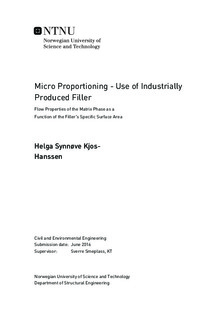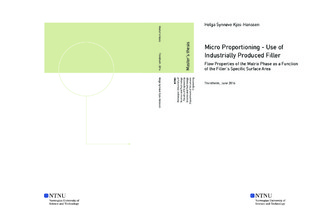| dc.description.abstract | Two water/cement-ratios (w/c), three filler contents (fi/c) within each w/c, and two admixture dosages within each fi/c, were measured. This resulted in twelve matrices with the Velde fillers to determine the matrix's flow properties for each of the cases. Including these, a redo of a set of three matrices from a previous study to indicate the fundamental flow properties for the disturbed results, with the low admixture dosage.
For each of the matrices, the flow resistance, yield shear stress, plastic viscosity, and the mini-slump spread were measured and compared to one another. The flow resistance was found through flow progress in the FlowCyl-apparatus. The yield shear stress and the plastic viscosity were found through measurements done in the rheometer machine, while the mini-slump spread was found through the mini-slump spread measurement.
In order to investigate the relation between the flow properties with the specific surface area (SSA), each of the filler's SSA had to be calculated. This was done through retrieving the particle size distribution (PSD) from a combination of mechanical sieving and a SediGraph analysis. A PSD is the particle grading curve of a filler, indicating the mass percentage of each particle size. The SediGraph works best when the maximum particle size of the analyzed sample is 63 micron. The particles above 63 micron were taken care of by mechanical sieving. The SSA is calculated by summarizing the surface area per particle, within each particle size, and multiplying that with the mass percentage of each particle size.
Through the results, some of the admixture dosages, for both w/c's, were revealed to be insufficient to reduce the matrix's yield shear stress to a negligible level. The matrices with the sufficient dosages indicate the relationships expected between the different flow properties. This means that the conclusion is based on the filler's effect on the flow properties with both sufficient and insufficient admixture dosages. What the results show is that when using a sufficient admixture dosage, the yield shear stress reduces to a point where it does not disturb the results. This implies that the matrix's flow resistance is closely related to the plastic viscosity. And the filler's effect on the flow resistance can be determined unambiguous and predictable with respect to SSA, given that a sufficient admixture dosage is used to reduce the yield shear stress to a negligible level. | |

